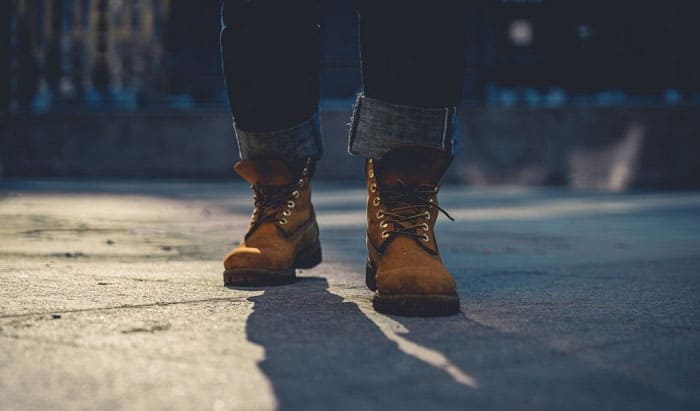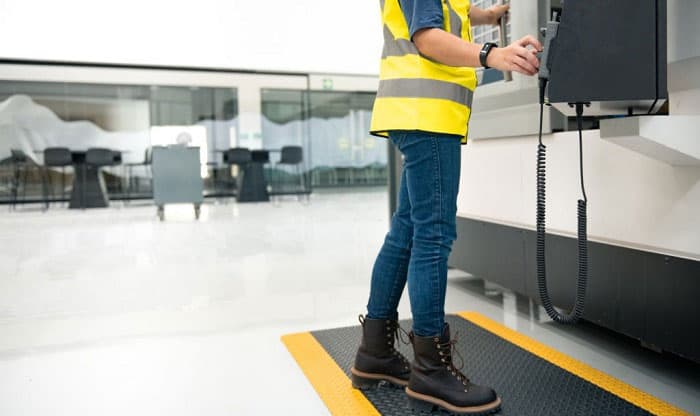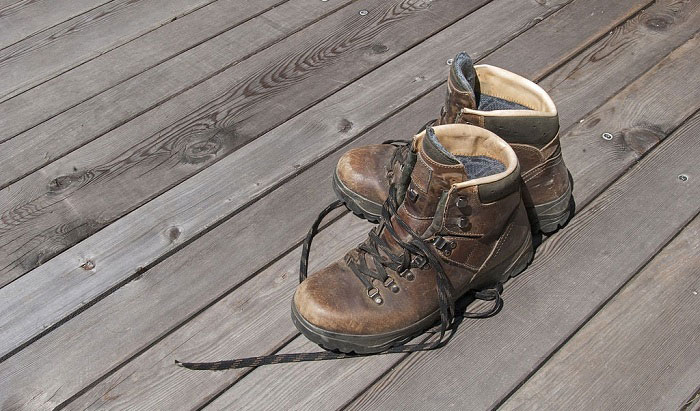Work boots can make a huge difference in ensuring employees’ safety, comfort, and productivity at hazardous worksites. Yet, ill-fitting safety boots will do just the opposite.
Walking, standing, or carrying loads in such boots is painful and tortuous. Even worse, it can lead to medical conditions like constant knee pain, athlete’s foot, or hammertoe in the long run. So, how should work boots fit? Should you buy boots a size bigger to avoid chafing?
Briefly, you should take note of the heels, uppers, and toe boxes when trying on work boots. The heels should fit snugly and move with your feet when you walk. The shoe upper parts shouldn’t put pressure on the bridge or side of your feet. Check that there is an inch of room between your longest toe and the end of the boot. You can size up to account for thick socks, but remember that loose shoes are not better than tight ones.
Table of Contents
Construction of a Safety Boot
When purchasing work footwear, there are many features you need to consider to ensure a good fit and maximal safety. Let’s take a glance at work boot anatomy so you can know which part we are talking about and why it should fit in a certain way.
- Upper: The upper part covers the entire foot. It can be one single piece or different pieces sewed together, including the tongue, toe box, shaft, and lining. A variety of materials can be used to make uppers, but the most common is leather.
- Safety toe: The toe box can be reinforced with a steel, alloy, or composite (fiberglass or carbon fiber) toe cap to resist the impact and compression of heavy objects. This feature is essential in heavy equipment jobs or constructions.
- Insole: Also known as the footbed, this part contacts the bottom of your feet and directly contributes to the overall comfort of the boots.
- Midsole: The midsole lies between the outer sole and the footbed. It provides shock absorption, durability, and sturdiness. Not every work boot comes with a midsole, though. Companies can reduce cost by taking away the midsole, which customers can hardly tell by eye.
- Shank: The shank is a thin and firm piece of steel or composite materials inserted in the midsole beneath the arch of the foot. It is to prevent punctures and support the arch.
- Outsole: The outsole can be from rubber, leather, or TPU (thermoplastic polyurethane). It determines how stable and balanced the boots can be. Manufacturers can add other properties such as insulation, slip resistance, oil resistance, and traction.
How Should Work Boots Fit?
There isn’t one answer to boot fitting for everyone because it depends on your personal preference. For instance, if you like to wear thick socks and add heel pads for extra comfort, sizing work boots up is a good idea.
But if you live in a hot climate, thin socks might feel more breathable. So, you should get boots that are true to your size. When you try on new boots, make sure you wear them with the socks or pads you prefer. Then, follow this work boot fit guide:
- Your heel should be cupped and fully supported. When you walk, your heel doesn’t come up high in the boot. The shoe moves with your feet without causing slippage. A tip is to go up the stairs with your new boots. The gravity will make your heel push against the shoe heel counter. Then, you can sense whether or not it fits and offers the right balance.
- The upper parts don’t put pressure on your feet, especially steel toe or metatarsal safety boots. Try rocking your feet from side to side to make sure your feet are comfortable in different positions. If the bridge or sides of your foot are cramped, you should size up.
- The toe box should allow enough room. Steel toe boots fit when you have a finger’s width distance between the longest toe and the end of the shoes. Tight boots cause chafing and blisters while loose boots cause your toes to slide forward and hit the front. The steel cap adds a little weight, so pay close attention to the toe room.
Refer to this video for how to make sure your boots fit:
Another handy tip is to keep an eye on the spaces between the eyelets. When you put on the boots and secure the laces, how much does the shoe tongue reveal? This can give you an idea of the fitting.
If the eyelet tabs are merely apart, it usually means the boot is too loose that you have to tie the laces tightly to make it fit. By the same token, if the tabs are too far away from each other, the boots are tight. Ideally, they should be around an inch apart as shown in the picture below.
In addition, leather boots stretch over time. Thus, avoid sizing up if not necessary. When buying boots online, you can order two pairs, try them on, choose the one that fits best, and return the other.
How to Size Work Boots
Not all brand sizes are the same, so don’t assume you know your size. Instead, measure your feet lengthwise with a measuring tape or ruler. Then, compare your figures with the work boot size guide on the brand’s website to get the correct sizing. Also, it helps to put on your favorite socks when you measure in case you need to size up for the socks.
Remember to measure both feet. It’s common to have a slight difference in size between the two feet. If that’s the case, we recommend opting for the size of the bigger foot. Another option is to get custom sizing, especially when you can’t find the right fit despite trying different brands.
Conclusion
With the increasing demand for high-risk jobs, comfortable safety footwear has never been more imperative. Learning how work boots should fit is highly important for your health and well-being. Well-fitted boots will help correct your postures, prevent injuries, and enhance comfort during long workdays.
We hope this article on how should work boots fit provides you with all the information you need. Nonetheless, don’t hesitate to contact us if you want further advice. See you next time!

Veronica is our content editor. She is a talent in delivery. Her main work is editing and writing articles that are both informative and simple to follow. She is in charge of synthesizing our understanding of what personal protection equipment (PPE) is needed in each job, how to best apply it, and how to visualize that equipment.




